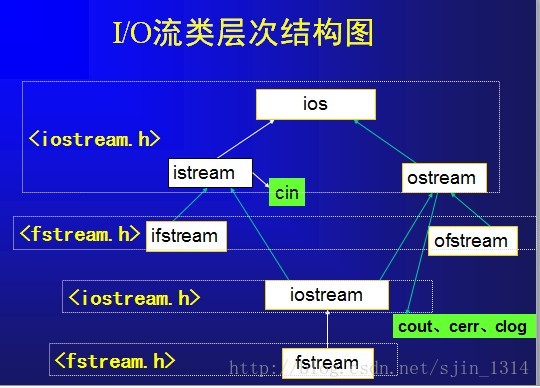流概述
流是C++标准的组成部分,流的主要目标是,将从磁盘读取文件或将输入写入控制台屏幕的问题封装起来,创建流后程序猿就能够使用它。流将负责处理全部的细节。
IO类库
在C++输入、输出操作是通过C++系统提供的完毕I/O操作的一组类实现的。主要包括:
标准流类:处理与标准输入设备(键盘)和输出设备(显示器)关联的数据流
文件流类:处理与磁盘文件关联的数据流
字符串流类:利用内存中的字符数组处理数据的输入输出


/*File : cerr.cpp
*Auth : sjin
*Date : 20140506
*Mail : 413977243@qq.com
*/
#include <iostream>
using namespace std;
/*格式化输出
*输出缓冲遇到换行,有输入、满、程序结果、flush会刷新
*/
int main()
{
char ch;
cerr << "World "; /*无缓冲。不可重定向*/
cin >> ch;
clog << "Clog "; /*理论上“缓冲,不可重定向”实际上无缓冲*/
cout << "Hello "; /*缓冲,可重定向*/
//输入随意字符退出
cin >> ch;
return 0;
}看输出:

/*File : get.cpp
*Auth : sjin
*Date : 20140506
*Mail : 413977243@qq.com
*/
#include <iostream>
using namespace std;
int main()
{
char ch;
while((ch = cin.get()) != EOF ){
if (ch == '$'){
break;
}
cout <<"ch = " << ch << endl;
}
cout << "Done" << endl;
cin.ignore(10,'
');
char s[25];
cin.get(s,25);
cout << s << endl;
return 0;
}输出结果:

/*File : cerr.cpp
*Auth : sjin
*Date : 20140506
*Mail : 413977243@qq.com
*/
#include <iostream>
#include <string>
using namespace std;
/*i.get() 从键盘输入一个字符
*o.put() 往屏幕输出一个字符
*i.getline() 从键盘输入一串字符串
*i.putback() 插入字符。
*i.peek() //查看输入缓冲区的第一个字符
*/
void get_put()
{
cout << "####请输入四个字符或者数字###" << endl;
int n = cin.get();
char c,d,e;
cin.get(c).get(d).get(e);// istream& get(char& ch);
cout << "n = " <<n << endl;
cout << "c = " <<c << endl;
cout << "d = " <<d << endl;
cout << "e = " <<e << endl;
cout << "还有一种输出方法" <<endl;
cout.put(n).put(c).put(d).put(e);
//忽略前200个字符除非遇到字符'
',而停止忽略字符
cin.ignore(200,'
');
char ch;
cin >> ch;
cout << "ch = " <<ch << endl;
cin.ignore(200,'
');
}
void mygetline()
{
char buf[10]={'�'};
cout << "####start getline ###" <<endl;
cout << "cin.getline 输入字符串。长度不要超过9个,'�' 10个" <<endl;
cin.clear();
if(!cin.getline(buf,sizeof(buf))){
cout << "行输入过长,错误" <<endl;
cin.clear();
/*清除输入过长的部分,应该不会超过1000个吧!*/
cin.ignore(1000,'
');
}
string s;
cout << "使用getline 全局函数输入字符串:" <<endl;
getline(cin,s);//getline(cin,s,'s')
cout << "buf = " << buf<<endl;
cout << "s = " << s << endl;
cout << "printf 输出s :" <<endl;
printf("%s
",s.c_str());
cout << "####end getline ###" <<endl;
}
void mypeek()
{
char buf[10];
char c;
cout << "请输入一个字符," << endl;
cin >>ws;//屏蔽掉空格
c = cin.get();
cin.putback(c);
if(cin.peek()> '0' && cin.peek() < '9'){
double d;
cout <<"请输入一个浮点数" << endl;
cin >> d;
cout << "d = " << d << endl;
}else{
string s;
cout <<"请输入一串字符串" << endl;
cin >> s ;
cout <<"s = " << s << endl;
}
}
int main2()
{
//get_put();
//mygetline();
//mypeek();
return 0;
}文件的输入和输出:
/*File : file.cpp
*Auth : sjin
*Date : 20140506
*Mail : 413977243@qq.com
*/
#include <iostream>
#include <fstream>
using namespace std;
char filename[80];
/*打开文件进行读写*/
void fout_fin()
{
char buffer[255];
cout << "请输入文件名称字:" << endl;
cin >> filename;
ofstream fout(filename);// open for writing
fout << "####start######" << endl;
cout << "输入一字符串写入文件里" << endl;
cin.ignore(1,'
');//重新启动新行(将刚才输入的文件名称忽略掉)。写入文件里,
cin.getline(buffer,255);
fout <<buffer <<endl;
fout << "####end####" << endl;
fout.close();
ifstream fin(filename);
cout << "###### 输入文件的内容" << endl;
while(fin.getline(buffer,255)){
cout <<buffer<<endl;
}
fin.close();
}
/*打开文件的默认行为
* ios::app: 附加到已有文件的末尾,而不是删除其内容
* ios::ate: 跳到文件末尾,但能够在文件的人和地方写入数据
* ios::truc: 默认值,删除已有文件的内容
* ios::binary: 以二进制方式打开文件。缺省的方式是文本方式。两种方式的差别见前文
* ios::in : 以输入方式打开
* ios::out: 以输出方式打开
*/
/*在文件末尾追加内容*/
void append_file()
{
ofstream fout;
char buff[256];
fout.open(filename,ios::app);
if(!fout){
cout << "打开文件失败。" << endl;
return;
}
cout << "追加一字符串写入文件里" <<endl;
cin.getline(buff,256);
fout <<"#### start append file ####" <<endl;
fout << buff << endl;
fout <<"#### end append file ####" <<endl;
fout.close();
ifstream fin(filename);
if(!fin){
cout <<"打开文件失败。
" <<endl;
return;
}
cout << "###### 输入文件的内容" << endl;
while(fin.getline(buff,256)){
cout <<buff<<endl;
}
fin.close();
}
int main()
{
fout_fin();
append_file();
return 0;
}
输出:

3、strstream ostrstream istrstream
控制字符串字符的输入和输出流。
/*File : strstream.cpp
*Auth : sjin
*Date : 20140506
*Mail : 413977243@qq.com
*/
#include <iostream>
#include <strstream>
using namespace std;
/*istrstream类用于运行C风格的串流的输入操作,也就是以字符串数组作为输入设备。
*ostrstream类用于运行C风格的串流的输出操作,也就是一字符串数组作为输出设备。
*strstream类同一时候能够支持C风格的串流的输入输出操作。
*
*利用istrstream类创建类对象,制定流输入设备为字符串数组,
*通过它向一个字符型对象输入数据
*/
void in_str()
{
char *name = "my name is sjin";
int size = strlen(name)+1;
istrstream istr(name,size);
//strstream istr(name,size,ios::in);
char temp[100];
istr.getline(temp,100);
cout << temp << endl;
}
/*类ostrstream用于运行串流的输出
*/
void out_str()
{
char *buf = new char[10];
char *ptemp = "sjin";
ostrstream ostr(buf,10,ios::out);
//使用ostrstream输出到流对象的时候,用ends结束字符串
ostr<<ptemp<<ends;
cout << buf <<endl;
delete[] buf;
}
int main()
{
in_str();
out_str();
return 0;
}
4、stringstream
/*File : sstream.cpp
*Auth : sjin
*Date : 20140506
*Mail : 413977243@qq.com
*/
#include <iostream>
#include <string>
#include <sstream>
using namespace std;
void convert_type()
{
stringstream sstr;
int a = 100;
//
sstr<< a;
cout <<"a :"<<a<<" 转换成字符串:"<< sstr.str() << endl;
sstr.clear();//why can not clear??
string name= "colinguan";
char cname[200];
sstr << name;
sstr>>cname;
cout << cname;
}
int main()
{
stringstream ostr("sjin123123123123123123123123123123123");
ostr.put('d');
ostr.put('e');
ostr << " love me";
cout << ostr.str() << endl;
char buff[1024];
ostr.getline(buff,1024);
cout <<buff << endl;
convert_type();
return 0输出:
5 io-state 输入输出的状态
C++中负责的输入/输出的系统包括了关于每个输入/输出操作的结果的记录信息。
这些当前的状态信息被包括在io_state类型的对象中。io_state是一个枚举类型(就像open_mode一样),以下便是它包括的值。
goodbit 无错误
Eofbit 已到达文件尾
failbit 非致命的输入/输出错误。可挽回 badbit 致命的输入/输出错误,无法挽回
有两种方法能够获得输入/输出的状态信息。
一种方法是通过调用rdstate()函数:
还有一种方法则是使用以下不论什么一个函数来检測对应的输入/输出状态: bool bad();bool eof();bool fail();bool good();
/*File : io_state.cpp
*Auth : sjin
*Date : 20140506
*Mail : 413977243@qq.com
*/
#include <iostream>
#include <string>
#include <sstream>
using namespace std;
void io_state()
{
int a;
cin >> a;
cout <<cin.rdstate() <<endl;
if(cin.rdstate() == ios::goodbit){
cout << "rdstate输入数据的类型正确,无错误" <<endl;
}
if(cin.rdstate() == ios_base::failbit){
cout <<"rdstate输入数据类型错误。非致命错误,可清除输入缓冲区" <<endl;
}
cin.clear();
cin.clear(ios::goodbit);
}
void good_fail()
{
int a;
cin >> a;
cout <<cin.rdstate() <<endl;
if(cin.good()){
cout << "good_fail输入数据的类型正确,无错误" <<endl;
}
if(cin.fail()){
cout <<"good_fail输入数据类型错误,非致命错误,可清除输入缓冲区" <<endl;
}
}
int main()
{
cout << "输入正确类型 11" << endl;
io_state();
cout << "输入正确类型 C" << endl;
io_state();
//还有一种方法则是使用以下不论什么一个函数来检測对应的输入/输出状态: bool bad();bool eof();bool fail();bool good();
cout << "输入正确类型 11" << endl;
good_fail();
cout << "输入正确类型 C" << endl;
good_fail();
}參考资料:
